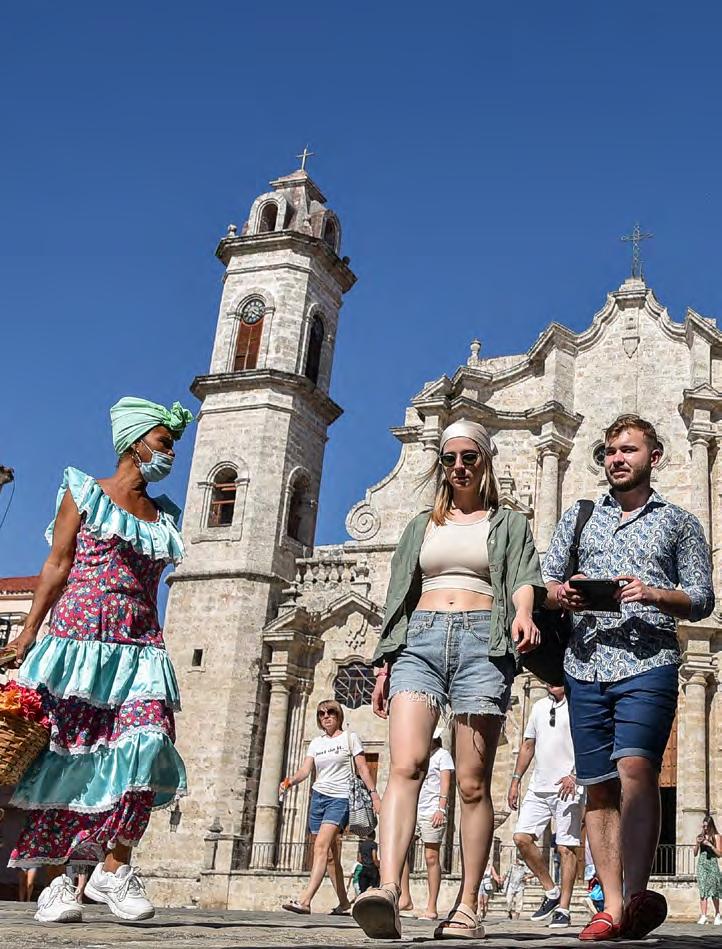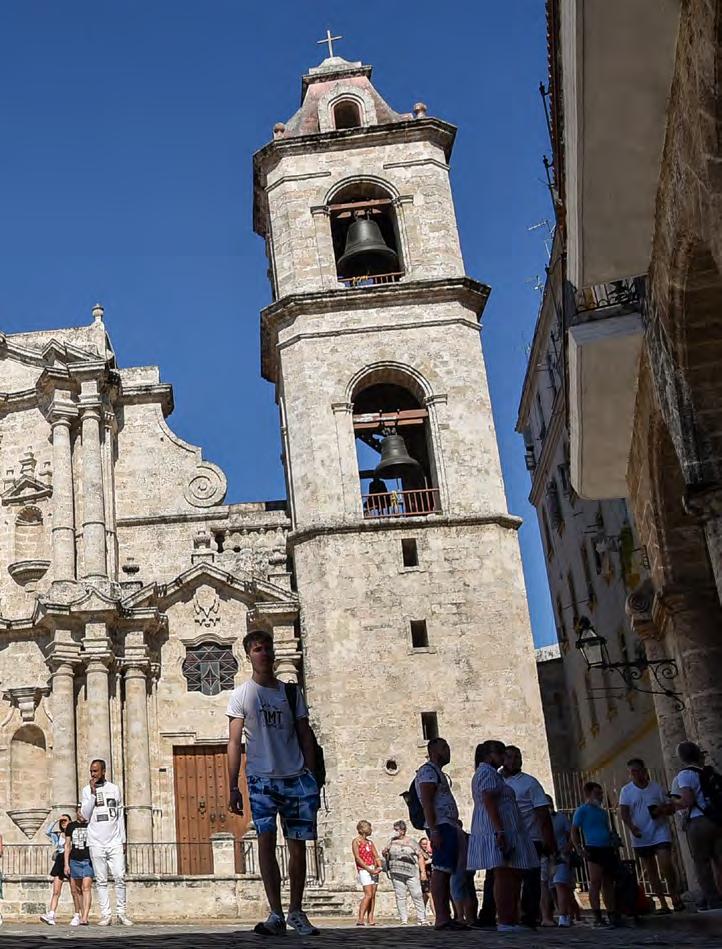
7 minute read
REPORTAJE
PLAZA DE LA CATEDRAL:
HABANERA, COLONIAL Y BARROCA»
Textos y fotos / Texts and photos: Bienvenidos
Visitada, continuamente, por cubanos y turistas de todas las naciones, la hermosa Plaza de la Catedral, con su encanto barroco, continúa siendo un lugar magnífico para comenzar un recorrido por la Vieja Habana. Su fisonomía es de esas que influyen, del modo más a apasionado, en el sincretismo arquitectónico que define a la capital de Cuba. Recorrerla, a través de sus adoquines de piedra, es una evocación a siglos pasados. Todo en ella encanta y entusiasma. Su génesis fue discreta pues cuando aún La Habana era una pequeña y caprichosa ciudadela amurallada, la hoy famosa Plaza de La Catedral, no era más que una plazuela a la que acudían los pobladores en busca de agua.

Plaza de la Catedral: Havana, colonial and baroque
Constantly visited by Cubans and tourists from all nations, the beautiful Cathedral Square, with its baroque charm, continues to be a magnificent place to begin a tour of Old Havana. Its appearance is one of those that influences, in the most passionate way, the architectural syncretism that defines the capital of Cuba. Walking through its cobblestones is an evocation of past centuries. Everything in it enchants and excites. Its genesis was discreet because when Havana was still a small and whimsical walled citadel, the now famous Cathedral Square was nothing more than a small square where the inhabitants went in search of water.

El siglo XVI la vio nacer, siendo por entonces un espacio pantanoso donde quedaban retenidas las aguas de lluvia, en su recorrido hasta la bahía, por ello su nombre inicial fue Plaza de la Ciénaga. Pero como todos los sitios destinados a despuntar y asumir un lugar relevante en la vida de una urbe, esta plaza tenía designada su buena ventura. Próxima al mar -medio imprescindible para el desarrollo de la ciudad- y elegida en principio, por la Orden eclesiástica de los Jesuita para levantar su templo, religión y sociedad hicieron de ella el símbolo que es hoy. Convertida La Habana en cabecera de Diócesis, la entonces Parroquial Mayor erigida en el siglo XVIII, pasó a servir como Catedral y el espacio que se extendía ante ella, fue bautizado como Plaza de la Catedral, hoy parte importantísima del Centro Histórico de la ciudad, avalado por la UNESCO como patrimonio mundial. Entre sus construcciones más espléndidas sobresale la Catedral de La Habana, el más fiel exponente del barroco en Cuba, su fachada cincelada en piedra trasmite a quien la contempla un movimiento constante. Describirla no es suficiente, nació para ser admirada con detenimiento. Según el escritor cubano Alejo Carpentier, esta extraordinaria edificación es música esculpida en piedra. Además de sus actividades litúrgicas y sus valores arquitectónicos, la iglesia posee un interior espléndido y sus notorias obras de arte aumentan su valía, entre ellos se encuentran óleos del artista francés Jean-Baptiste Vermay, frescos del italiano Giuseppe Perovani y lienzos de la Virgen de Loreto, bendecida por el obispo Morell de Santa Cruz en 1755, y de la Virgen de la Purísima Concepción, Patrona de La Catedral.
It was born in the 16th century, being at that time a swampy space where rainwater was retained on its way to the bay, hence its initial name was Plaza de la Ciénaga (Swamp Square). But like all places destined to emerge and assume a relevant spot in the life of a city, this square had its good fortune. Close to the sea -an essential means for the development of the city- and chosen in principle by the Jesuit Ecclesiastical Order to build its temple; religion and society made of it the symbol it is today. When Havana became the head of the Diocese, the then Parroquial Mayor, built in the 18th century, became the Cathedral and the space before it was baptized Plaza de la Catedral, today a very important part of the Historic Center of the city, declared a World Heritage Site by UNESCO. Among its most splendid constructions stands out the Havana Cathedral, the most faithful exponent of baroque in Cuba, its facade chiseled in stone transmits to those who contemplate it a constant movement. It is not enough to describe it; it was born to be admired in detail. According to Cuban writer Alejo Carpentier, this extraordinary building is music sculpted in stone. In addition to its liturgical activities and architectural values, the church has a magnificent interior and its notorious works of art increase its value. Among them are oil paintings by French artist Jean-Baptiste Vermay, frescoes by Italian Giuseppe Perovani and canvases of the Virgin of Loreto, blessed by Bishop Morell de Santa Cruz in 1755, and of the Virgin of the Immaculate Conception, Patroness of the Cathedral.

Su adoquinada explanada, que fuera escenario de fiestas, ferias y mercados comunitarios en los añejos siglos XVI y XVII, fue codiciada por hacendados y comerciantes con títulos nobiliarios, quienes levantaron en sus alrededores, fastuosos palacetes de doble planta, con prominentes portales, amplios salones y patio interior. Así, muchas familias de abolengo, entre ellos los Marqueses de Aguas Claras, los de Arcos, los de Lombillo, aportaron a la plaza la apariencia arquitectónica tan maravillosa que hoy se disfruta. La construcción de lujosas mansiones dotó a la plaza de vida propia, cada casona con historias sorprendentes. La primera de las viviendas fue la casa del conde Bayona, justo al frente de la catedral, su propietario fue uno de los gobernadores militares de Cuba, Don Luis Chacón que casó a su hija con el primer conde de Casa Bayona, de ahí el nombre del palacete, donde radica hoy el Museo de Arte Colonial. Otra de las más vetustas casonas de la plaza es la del Marqués de Arcos, que atesora entre sus valores, la más acabada pieza de herrería de toda La Habana colonial y que sirve de adorno a su imponente balcón. La casa del Conde Lombillo, a continuación de esta, sobresale por su sobriedad y en su amplio pórtico, destaca, recostado a una de sus imponentes columnas, la estatua de Antonio Guedes, el reconocido español, bailarín de flamenco, entrañable amigo de Cuba. Y para finalizar este recorrido por la más barroca de las plazas habaneras, se impone una invitación; un alto en el transitar por la bella plazoleta capitalina: el restaurante El Patio, una verdadera joya constructiva donde sobresalen su monumental portal y sus coloridos vitrales que le dan al interior una suerte de cálido recinto tropical. Allí, el tradicional arte culinario cubano satisface el gusto de sus comensales que se sienten, además, acogidos cual nobles señores, en lo que fuera durante el siglo XVIII la Casa de los Marqueses de Aguas Claras. Venga pues, el visitante ávido de historias y secretos a desandar una plaza colonial y barroca, tantas veces recreada por cronistas, poetas, grabadores. Un espacio con magia, una sinfonía de la belleza urbanística, en el mismo corazón de la Habana Vieja.


Its cobblestone esplanade, which was the scene of festivals, fairs and community markets in the old XVI and XVII centuries, was coveted by landowners and merchants with noble titles, who built in its surroundings, sumptuous two-story palaces, with prominent portals, spacious halls and inner courtyard. Thus, many noble families, among them the Marquises of Aguas Claras, the Marquises of Arcos and the Marquises of Lombillo, gave the square the wonderful architectural appearance that is enjoyed today. The construction of luxurious mansions gave the square a life of its own, each mansion with surprising stories. The first of the houses was the house of Count Bayona, right in front of the cathedral, its owner was one of the military governors of Cuba, Don Luis Chacón who married his daughter to the first Count of Casa Bayona, hence the name of the mansion, where today the Museum of Colonial Art is located. Another of the most ancient mansions of the square is that of the Marquis of Arcos, which treasures among its values, the most finished piece of blacksmithing of all colonial Havana and that serves as an ornament to its imposing balcony. The house of Count Lombillo, next to this one, stands out for its sobriety and in its wide portico, stands out, leaning against one of its imposing columns, the statue of Antonio Guedes, the renowned Spaniard, flamenco dancer, dear friend of Cuba. And to end this tour of the most baroque of Havana's squares, an invitation is in order; a stop in the journey through the beautiful square of the capital: the restaurant El Patio, a true architectural jewel where its monumental portal and its colorful stained-glass windows stand out, giving the interior a kind of warm tropical enclosure. There, the traditional Cuban culinary art satisfies the taste of its guests, who also feel welcomed like noble lords in what used to be the House of the Marquises of Aguas Claras during the 18th century. Come, then, the visitors eager for stories and secrets to retrace a colonial and baroque square, so many times recreated by chroniclers, poets, engravers. A magical space, a symphony of urban beauty in the very heart of Old Havana.






